Gmc Yukon XL Denali 2015, Yukon Denali 2015 User Manual
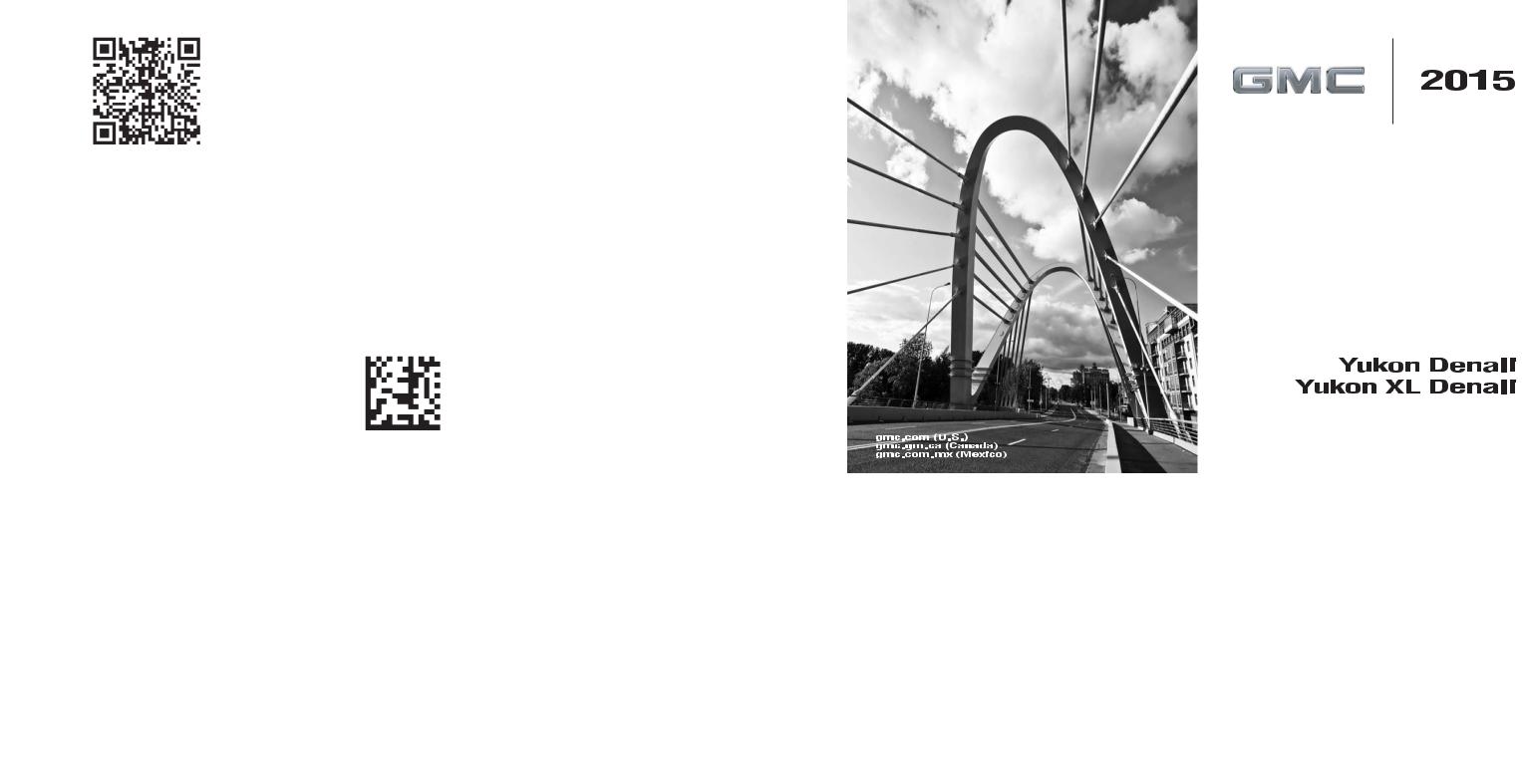

2015 GMC Yukon Denali/Yukon XL Denali Owner Manual M
In Brief . . . . . . . . . . . . . . . . . . . . . . . . 1-1
Instrument Panel . . . . . . . . . . . . . . 1-2
Initial Drive Information . . . . . . . . 1-4
Vehicle Features . . . . . . . . . . . . . 1-17
Performance and
Maintenance . . . . . . . . . . . . . . . . 1-21
Keys, Doors, and
Windows . . . . . . . . . . . . . . . . . . . . 2-1
Keys and Locks . . . . . . . . . . . . . . . 2-1
Doors . . . . . . . . . . . . . . . . . . . . . . . . 2-13
Vehicle Security. . . . . . . . . . . . . . 2-19
Exterior Mirrors . . . . . . . . . . . . . . . 2-22
Interior Mirrors . . . . . . . . . . . . . . . . 2-24
Windows . . . . . . . . . . . . . . . . . . . . . 2-25
Roof . . . . . . . . . . . . . . . . . . . . . . . . . . 2-28
Seats and Restraints . . . . . . . . . 3-1
Head Restraints . . . . . . . . . . . . . . . 3-2
Front Seats . . . . . . . . . . . . . . . . . . . . 3-3
Rear Seats . . . . . . . . . . . . . . . . . . . . 3-9
Safety Belts . . . . . . . . . . . . . . . . . . 3-16
Airbag System . . . . . . . . . . . . . . . . 3-26
Child Restraints . . . . . . . . . . . . . . 3-39
Storage . . . . . . . . . . . . . . . . . . . . . . . 4-1
Storage Compartments . . . . . . . . 4-1
Additional Storage Features . . . 4-3
Roof Rack System . . . . . . . . . . . . . 4-4
Instruments and Controls . . . . 5-1
Controls . . . . . . . . . . . . . . . . . . . . . . . 5-2
Warning Lights, Gauges, and
Indicators . . . . . . . . . . . . . . . . . . . 5-10
Information Displays . . . . . . . . . . 5-30
Vehicle Messages . . . . . . . . . . . . 5-37
Vehicle Personalization . . . . . . . 5-50
Universal Remote System . . . . 5-58
Lighting . . . . . . . . . . . . . . . . . . . . . . . 6-1
Exterior Lighting . . . . . . . . . . . . . . . 6-1
Interior Lighting . . . . . . . . . . . . . . . . 6-6
Lighting Features . . . . . . . . . . . . . . 6-7
Infotainment System . . . . . . . . . 7-1
Introduction . . . . . . . . . . . . . . . . . . . . 7-1
Climate Controls . . . . . . . . . . . . . 8-1
Climate Control Systems . . . . . . 8-1
Air Vents . . . . . . . . . . . . . . . . . . . . . . . 8-6
Maintenance . . . . . . . . . . . . . . . . . . . 8-7
Driving and Operating . . . . . . . . 9-1
Driving Information . . . . . . . . . . . . . 9-2
Starting and Operating . . . . . . . 9-19
Engine Exhaust . . . . . . . . . . . . . . 9-28
Automatic Transmission . . . . . . 9-29
Drive Systems . . . . . . . . . . . . . . . . 9-35
Brakes . . . . . . . . . . . . . . . . . . . . . . . 9-38
Ride Control Systems . . . . . . . . 9-41
Cruise Control . . . . . . . . . . . . . . . . 9-44
Driver Assistance Systems . . . 9-54
Fuel . . . . . . . . . . . . . . . . . . . . . . . . . . 9-66
Trailer Towing . . . . . . . . . . . . . . . . 9-70
Conversions and Add-Ons . . . 9-84
Vehicle Care . . . . . . . . . . . . . . . . . 10-1
General Information . . . . . . . . . . 10-2
Vehicle Checks . . . . . . . . . . . . . . . 10-3
Headlamp Aiming . . . . . . . . . . . 10-27
Bulb Replacement . . . . . . . . . . 10-27
Electrical System . . . . . . . . . . . . 10-30
Wheels and Tires . . . . . . . . . . . 10-41

2015 GMC Yukon Denali/Yukon XL Denali Owner Manual M
Jump Starting . . . . . . . . . . . . . . . 10-74
Towing the Vehicle . . . . . . . . . . 10-77
Appearance Care . . . . . . . . . . . 10-81
Service and Maintenance . . . 11-1
General Information . . . . . . . . . . 11-1
Maintenance Schedule . . . . . . . 11-3
Special Application
Services . . . . . . . . . . . . . . . . . . . . 11-7
Additional Maintenance
and Care . . . . . . . . . . . . . . . . . . . . 11-7
Recommended Fluids,
Lubricants, and Parts . . . . . . 11-11
Maintenance Records . . . . . . . 11-14
Technical Data . . . . . . . . . . . . . . . 12-1
Vehicle Identification . . . . . . . . . 12-1
Vehicle Data . . . . . . . . . . . . . . . . . . 12-2
Customer Information . . . . . . . 13-1
Customer Information . . . . . . . . 13-1
Reporting Safety Defects . . . . 13-13
Vehicle Data Recording and
Privacy. . . . . . . . . . . . . . . . . . . . 13-14
OnStar . . . . . . . . . . . . . . . . . . . . . . . 14-1
OnStar Overview. . . . . . . . . . . . . 14-1
OnStar Services . . . . . . . . . . . . . . 14-2
OnStar Additional
Information . . . . . . . . . . . . . . . . . . 14-6
Index . . . . . . . . . . . . . . . . . . . . . i-1

Introduction iii
The names, logos, emblems, slogans, vehicle model names, and vehicle body designs appearing in this manual including, but not limited to, GM, the GM logo, GMC, the GMC Truck Emblem, YUKON, and DENALI are trademarks and/or service marks of General Motors LLC, its subsidiaries, affiliates,
or licensors.
For vehicles first sold in Canada, substitute the name “General Motors of Canada Limited” for GMC wherever it appears in this manual.
This manual describes features that may or may not be on the vehicle because of optional equipment that was not purchased on the vehicle, model variants, country specifications, features/applications that may not be available in your region, or changes subsequent to the printing of this owner manual.
Refer to the purchase documentation relating to your specific vehicle to confirm the features.
Keep this manual in the vehicle for quick reference.
Canadian Vehicle Owners
Propriétaires Canadiens
A French language manual can be obtained from your dealer, at www.helminc.com, or from:
On peut obtenir un exemplaire de ce guide en français auprès du concessionnaire ou à l'adresse savant:
Helm, Incorporated
Attention: Customer Service
47911 Halyard Drive
Plymouth, MI 48170
Litho in U.S.A. |
© 2014 General Motors LLC. All Rights Reserved. |
Part No. 23168273 B Second Printing |
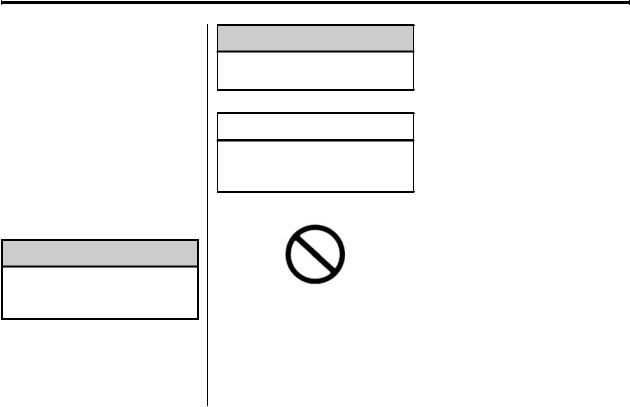
iv Introduction
Using this Manual
To quickly locate information about the vehicle, use the Index in the back of the manual. It is an alphabetical list of what is in the manual and the page number where it can be found.
Danger, Warnings, and
Cautions
Warning messages found on vehicle labels and in this manual describe hazards and what to do to avoid or reduce them.
{Danger
Danger indicates a hazard with a high level of risk which will result in serious injury or death.
{Warning
Warning indicates a hazard that could result in injury or death.
{Caution
Caution indicates a hazard that could result in property or vehicle damage.
A circle with a slash through it is a safety symbol which means “Do Not,” “Do not do this,” or “Do not let this happen.”
Symbols
The vehicle has components and labels that use symbols instead of text. Symbols are shown along with the text describing the operation or information relating to a specific component, control, message, gauge, or indicator.
M : This symbol is shown when you need to see your owner manual for additional instructions or information.
* : This symbol is shown when you need to see a service manual for additional instructions or information.

Introduction v
Vehicle Symbol Chart
Here are some additional symbols that may be found on the vehicle and what they mean. For more information on the symbol, refer to the Index.
0 : Adjustable Pedals
9 : Airbag Readiness Light
! : Antilock Brake System (ABS)
g : Audio Steering Wheel Controls or OnStar® (if equipped)
$ : Brake System Warning Light
" : Charging System
I : Cruise Control
B : Engine Coolant Temperature
O : Exterior Lamps
# : Fog Lamps
. : Fuel Gauge
+ : Fuses
3 : Headlamp High/Low-Beam
Changer
( : Heated Steering Wheel
j : LATCH System Child
Restraints
* : Malfunction Indicator Lamp
: : Oil Pressure
g : Outside Power Foldaway
Mirrors
O : Power
/ : Remote Vehicle Start
> : Safety Belt Reminders
7 : Tire Pressure Monitor
_ : Tow/Haul Mode
d : Traction Control/StabiliTrak®
M : Windshield Washer Fluid

vi Introduction
2 NOTES

In Brief |
1-1 |
In Brief
Instrument Panel
Instrument Panel . . . . . . . . . . . . . . 1-2
Initial Drive Information
Initial Drive Information . . . . . . . . 1-4
Remote Keyless Entry (RKE)
System . . . . . . . . . . . . . . . . . . . . . . 1-4
Remote Vehicle Start . . . . . . . . . 1-5
Door Locks . . . . . . . . . . . . . . . . . . . 1-5
Liftgate . . . . . . . . . . . . . . . . . . . . . . . . 1-6
Windows . . . . . . . . . . . . . . . . . . . . . . 1-7
Seat Adjustment . . . . . . . . . . . . . . 1-7
Memory Features . . . . . . . . . . . . . 1-8
Second Row Seats . . . . . . . . . . . 1-9
Third Row Seats . . . . . . . . . . . . . . 1-9
Heated and Cooled Front
Seats . . . . . . . . . . . . . . . . . . . . . . . . 1-9
Head Restraint Adjustment . . . . 1-9
Safety Belts . . . . . . . . . . . . . . . . . . 1-10
Passenger Sensing
System . . . . . . . . . . . . . . . . . . . . . 1-10
Mirror Adjustment . . . . . . . . . . . . 1-10
Steering Wheel
Adjustment . . . . . . . . . . . . . . . . . 1-11
Throttle and Brake Pedal
Adjustment . . . . . . . . . . . . . . . . . 1-12
Interior Lighting . . . . . . . . . . . . . . 1-12
Exterior Lighting . . . . . . . . . . . . . 1-13
Windshield Wiper/Washer . . . . 1-14
Climate Controls . . . . . . . . . . . . . 1-15
Transmission . . . . . . . . . . . . . . . . 1-15
Four-Wheel Drive . . . . . . . . . . . . 1-16
Vehicle Features
Infotainment System . . . . . . . . . 1-17
Steering Wheel Controls . . . . . 1-17
Cruise Control . . . . . . . . . . . . . . . 1-17
Driver Information
Center (DIC) . . . . . . . . . . . . . . . 1-17
Forward Collision Alert (FCA)
System . . . . . . . . . . . . . . . . . . . . . 1-18
Lane Departure
Warning (LDW) . . . . . . . . . . . . . 1-18
Lane Change Alert (LCA) . . . . 1-18
Rear Vision
Camera (RVC) . . . . . . . . . . . . . 1-19
Rear Cross Traffic Alert
(RCTA) System . . . . . . . . . . . . 1-19
Parking Assist . . . . . . . . . . . . . . . 1-19
Active Emergency Braking
System . . . . . . . . . . . . . . . . . . . . . 1-19
Power Outlets . . . . . . . . . . . . . . . 1-19
Universal Remote System . . . 1-20
Sunroof . . . . . . . . . . . . . . . . . . . . . . 1-20
Performance and Maintenance
Traction Control/Electronic Stability Control . . . . . . . . . . . . 1-21
Tire Pressure Monitor . . . . . . . . 1-22 Engine Oil Life System . . . . . . 1-22 Driving for Better Fuel
Economy . . . . . . . . . . . . . . . . . . . 1-23 Roadside Assistance
Program . . . . . . . . . . . . . . . . . . . . 1-23 OnStar® . . . . . . . . . . . . . . . . . . . . . 1-23
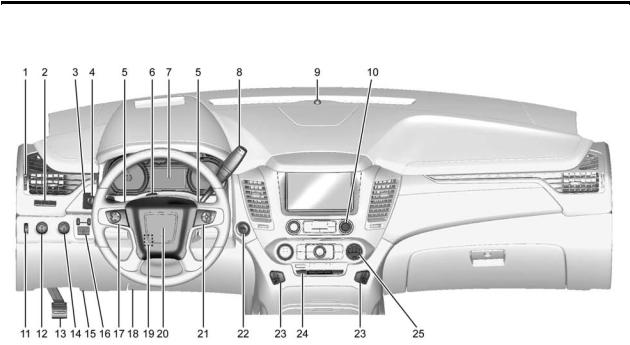
1-2 In Brief
Instrument Panel

In Brief |
1-3 |
1.Air Vents on page 8-6.
2.Head-Up Display (HUD) on page 5-33.
3.g Traction Control/Electronic Stability Control on page 9-41.
jPower Assist Steps on page 2-18 (If Equipped).
XParking Assist Button (If Equipped). See Assistance Systems for Parking or Backing on page 9-55.
@Lane Departure Warning (LDW) on page 9-65 (If Equipped).
0 Pedal Adjust Switch (If Equipped). See Adjustable Throttle and Brake Pedal on page 9-19.
4.Turn Signal Lever. See Turn and Lane-Change Signals on
page 6-5.
Windshield Wiper/Washer on page 5-3.
5.Favorite Switches (Out of View). See Steering Wheel Controls on page 5-2.
Volume Switches (Out of View). See Steering Wheel Controls on page 5-2.
6.Hazard Warning Flashers on page 6-4.
7.Instrument Cluster on page 5-11.
8.Shift Lever. See Automatic Transmission on page 9-29.
Tow/Haul Selector Button. See
Tow/Haul Mode on page 9-34.
Range Selection Mode (If Equipped). See Manual Mode on page 9-32.
9.Light Sensor. See Automatic Headlamp System on page 6-3.
10.Infotainment on page 7-1.
11.Instrument Panel Illumination Control on page 6-6.
12.Exterior Lamp Controls on page 6-1.
Fog Lamps on page 6-5 (If Equipped).
13.Parking Brake on page 9-39.
14.Automatic Transfer Case Knob (If Equipped). See Four-Wheel Drive on page 9-35.
15.Data Link Connector (DLC) (Out of View). See Malfunction Indicator Lamp on page 5-20.
16.Trailer Brake Control Panel (If Equipped). See Towing Equipment on page 9-77.
17.Cruise Control on page 9-44.
Adaptive Cruise Control on page 9-47 (If Equipped).
Forward Collision Alert (FCA) System on page 9-58 (If Equipped).
18.Hood Release. See Hood on page 10-4.
19.Steering Wheel Adjustment on page 5-2.
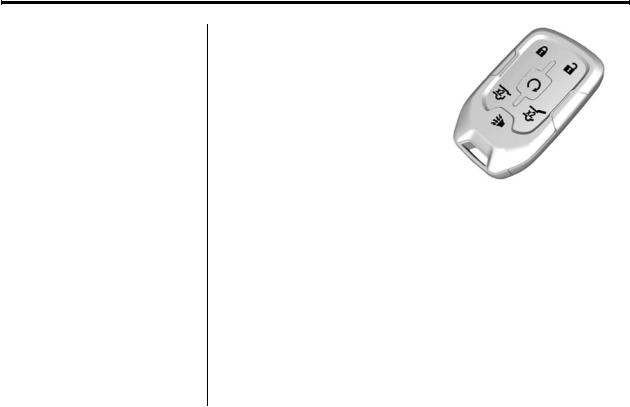
1-4 In Brief
20.Horn on page 5-3.
21.Steering Wheel Controls on page 5-2.
22.Ignition Positions on page 9-20.
23.Driver and Passenger Heated and Cooled Front Seat Buttons. See Heated and Cooled Front Seats on
page 3-7.
24.Rear Climate Control Buttons. See Rear Climate Control System on page 8-5.
25.Dual Automatic Climate Control System on page 8-1
Initial Drive
Information
This section provides a brief overview about some of the important features that may or may not be on your specific vehicle.
For more detailed information, refer to each of the features which can be found later in this owner manual.
Remote Keyless Entry
(RKE) System
The RKE transmitter is used to remotely lock and unlock the doors and it may work up to 60 m (197 ft) away from the vehicle.
K : Press to unlock the driver door. Press K again within three seconds to unlock all remaining doors.
Q : Press to lock all doors.
Lock and unlock feedback can be personalized. See Vehicle Personalization on page 5-50.
b : Press twice to open or close the liftgate. Press once to stop the liftgate from moving.
c : Press twice to open the liftglass.

In Brief |
1-5 |
7 : Press and release to initiate vehicle locate. The turn signal lamps flash and the horn sounds three times.
Press 7 and hold for more than three seconds to sound the panic alarm.
Press 7 again to cancel the panic alarm.
See Keys on page 2-1 and Remote Keyless Entry (RKE) System on page 2-2.
Remote Vehicle Start
If equipped, the engine can be started from outside of the vehicle.
Starting the Vehicle
1.Press and release Q.
2.Immediately, press and hold / for at least four seconds or until the turn signal lamps flash.
When the vehicle starts, the parking lamps will turn on. The doors will be locked and the climate control system may come on.
The engine will continue to run for 10 minutes. After 30 seconds, repeat the steps if a 10-minute extension is desired. Remote start can be extended only once.
Canceling a Remote Start
To cancel a remote start, do one of the following:
.Press and hold / until the parking lamps turn off.
.Turn on the hazard warning flashers.
.Turn the vehicle on and then off.
See Remote Vehicle Start on page 2-9.
Door Locks
To lock or unlock the doors from inside the vehicle:
.Press Q or K on a power door lock switch.
.Pushing down the manual lock knob on the driver door will lock all doors. Pushing down the lock knob on a passenger door will lock that door only.
.Pulling the door handle once will unlock that door. Pulling the handle again will unlatch it.
To lock or unlock the doors from outside the vehicle press Q or K on the RKE transmitter. See Remote Keyless Entry (RKE) System Operation on page 2-3.
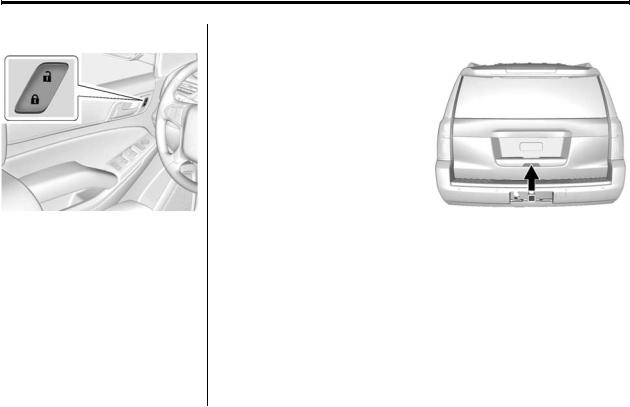
1-6 In Brief
Power Door Locks |
Keyless Access |
Liftgate |
|
If equipped with Keyless Access, |
|
|
the RKE transmitter must be within |
|
|
1 m (3 ft) of the driver door. |
|
|
Pressing the button on the driver |
|
|
door handle will unlock the driver |
|
|
door. If the handle button is pressed |
|
|
again within five seconds, the |
|
|
passenger doors and liftgate will |
|
|
unlock. See Remote Keyless Entry |
|
|
(RKE) System Operation on |
|
|
page 2-3. |
|
Q : Press to lock the doors.
K : Press to unlock the doors.
See Door Locks on page 2-11.
To open the liftgate, press K on the
power door lock switch or press K on the Remote Keyless Entry (RKE) transmitter twice to unlock all doors. Press the touch pad on the underside of the liftgate handle and lift up. See Remote Keyless Entry (RKE) System Operation on
page 2-3.
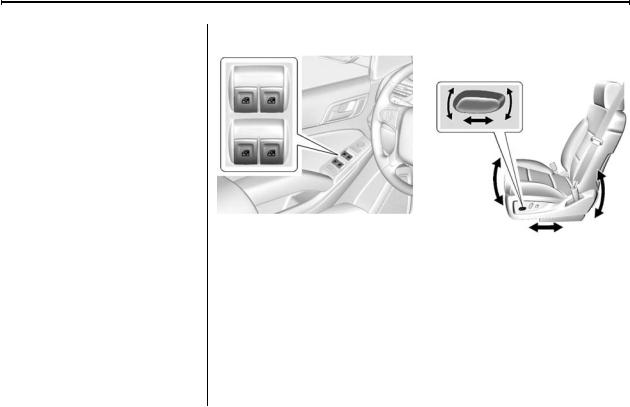
In Brief |
1-7 |
Use the pull cup to lower and close the liftgate. Do not press the touch pad while closing the liftgate. This will cause the liftgate to be unlatched.
Power Liftgate Operation
If equipped with a power liftgate, the switch is on the overhead console. The vehicle must be in P (Park).
Choose the power liftgate mode by selecting MAX or 3/4. Press 8on the overhead console. On the RKE transmitter press b twice quickly.
Pressing and releasing b while the liftgate is moving stops the liftgate. Pressing again reverses the direction.
To close, press lon the bottom of the liftgate next to the latch.
To disable the power liftgate function, select OFF on the liftgate switch. See Liftgate on page 2-13.
Windows
The power windows work when the ignition is in ON/RUN or ACC/ ACCESSORY, or in Retained Accessory Power (RAP). See
Retained Accessory Power (RAP) on page 9-25.
If equipped, the front and rear windows have an express-down feature. The front windows have an express-up feature. See Windows on page 2-25 and Power Windows on page 2-25.
Seat Adjustment
Power Seats
To adjust the seat:
.Move the seat forward or rearward by sliding the control forward or rearward.
.Raise or lower the front part of the seat cushion by moving the front of the control up or down.
.Raise or lower the seat by moving the rear of the control up or down.

1-8 In Brief
See Power Seat Adjustment on page 3-3.
Lumbar Adjustment
To adjust the lumbar support:
.Press and hold the control forward to increase or rearward to decrease upper and lower lumbar support at the same time.
.Press and hold the control up to increase upper lumbar support and decrease lower lumbar support.
Press and hold the control down to increase lower lumbar support and decrease upper lumbar support.
See Lumbar Adjustment on page 3-4.
Memory Features
The SET, "1," "2," and B (Exit) buttons on the driver door are used to manually save and recall memory settings for the driver seat, outside mirrors, power tilt and telescoping steering column, and adjustable pedals.
See Memory Seats on page 3-5 and Vehicle Personalization on
page 5-50.
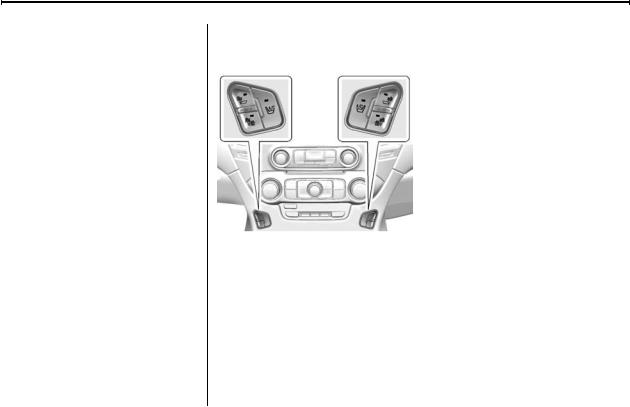
In Brief |
1-9 |
Second Row Seats
The second row seatbacks can be folded for additional cargo space, or the seats can be folded and tumbled for easy entry/exit to the third row seats. The seatbacks also recline.
See Second Row Seats on page 3-9.
Third Row Seats
Third row seatbacks can be folded. See Third Row Seats on page 3-14.
Heated and Cooled Front
Seats
The buttons are on the center stack below the climate control system. To operate, the engine must be running.
Press I to heat the driver or passenger seatback only.
Press J to heat the driver or passenger seat cushion and seatback.
Press A to cool the driver or passenger seat.
See Heated and Cooled Front Seats on page 3-7.
Head Restraint
Adjustment
Do not drive until the head restraints for all occupants are installed and adjusted properly.
To achieve a comfortable seating position, change the seatback recline angle as little as necessary while keeping the seat and the head restraint height in the proper position.
See Head Restraints on page 3-2 and Power Seat Adjustment on page 3-3.
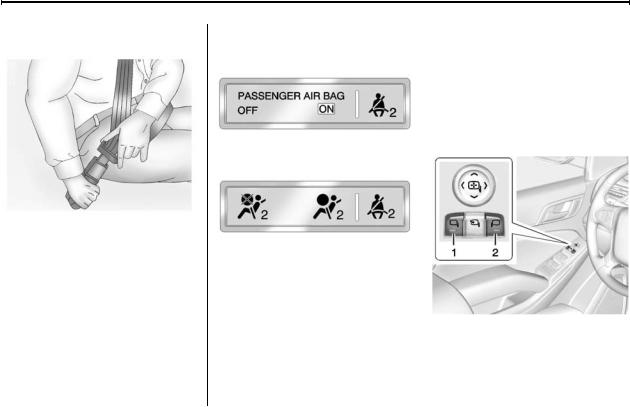
1-10 |
In Brief |
Safety Belts |
Passenger Sensing |
|
System |
Refer to the following sections for important information on how to use safety belts properly:
.Safety Belts on page 3-16.
.How to Wear Safety Belts Properly on page 3-18.
.Lap-Shoulder Belt on page 3-19.
.Lower Anchors and Tethers for Children (LATCH System) on page 3-47.
United States
Canada and Mexico
The passenger sensing system will turn off the front outboard passenger frontal airbag under certain conditions. No other airbag is affected by the passenger sensing system. See Passenger Sensing System on page 3-33.
The passenger airbag status indicator will light on the overhead console when the vehicle is started. See Passenger Airbag Status Indicator on page 5-19.
Mirror Adjustment
Exterior Mirrors
To adjust the mirrors:
1.Press (1) or (2) to select the driver or passenger side mirror.
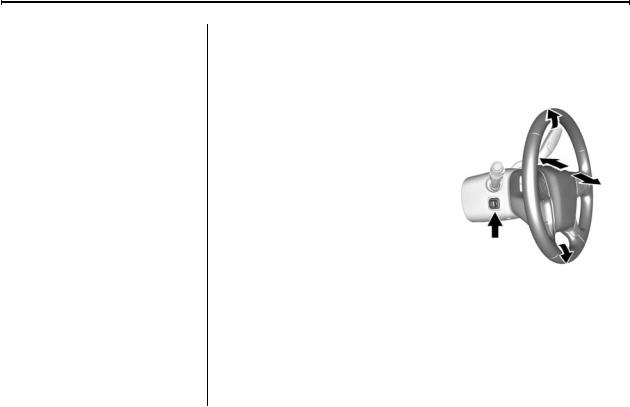
In Brief |
1-11 |
2.Press the arrows on the control pad to move each mirror in the desired direction.
3.Press either (1) or (2) again to deselect the mirror.
To power fold the mirrors:
1.Press { to fold the mirrors inward.
2.Press { again to return the mirrors to the driving position.
See Power Mirrors on page 2-22.
Heated Mirrors
Press 1to heat the mirrors.
See “Rear Window Defogger” under
Dual Automatic Climate Control System on page 8-1.
Interior Mirror
Adjustment
Adjust the mirror to view the area behind the vehicle.
Automatic Dimming Rearview
Mirror
The mirror automatically reduces the glare of headlamps from behind. The dimming feature comes on when the vehicle is started. See
Automatic Dimming Rearview Mirror on page 2-24.
Steering Wheel
Adjustment
Power Tilt and Telescope Steering
Wheel
To adjust the power tilt and telescope steering wheel, if equipped:
Press the control to move the steering wheel up and down or forward and rearward.
Do not adjust the steering wheel while driving.
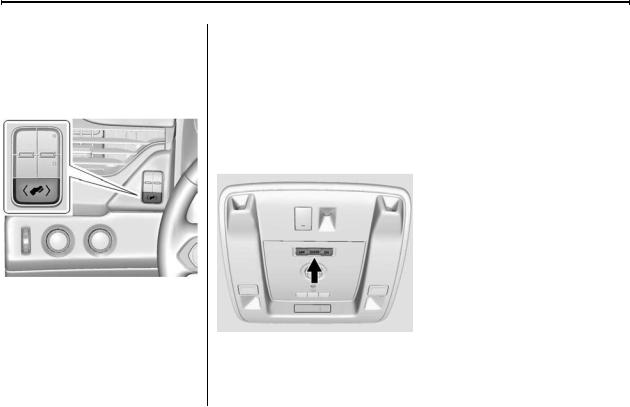
1-12 |
In Brief |
Throttle and Brake Pedal
Adjustment
If equipped, the position of the throttle and brake pedals can be changed.
The switch used to adjust the pedals is to the left of the steering wheel.
Press the switch to the left to move the pedals closer to your body. Press the switch to the right to move the pedals away.
See Adjustable Throttle and Brake Pedal on page 9-19.
The vehicle may have a memory function, which lets pedal settings be saved and recalled. See Memory Seats on page 3-5.
Interior Lighting
Dome Lamps
There are dome lamps in the overhead console and the headliner, if equipped.
To change the dome lamp settings, press the following:
OFF: Turns the lamps off, even when a door is open.
DOOR: The lamps come on automatically when a door is opened.
ON: Turns all dome lamps on.
Reading Lamps
There are reading lamps in the overhead console and the headliner, if equipped. To operate, the ignition must be in the ACC/ACCESSORY or ON/RUN position or using Retained Accessory Power (RAP).
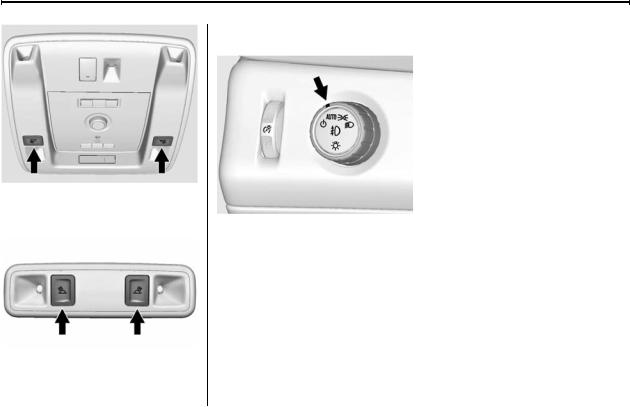
In Brief |
1-13 |
Press mor n next to each reading lamp to turn it on or off.
Exterior Lighting
The exterior lamp control is on the instrument panel to the left of the steering wheel.
There are four positions.
O : Turns off the automatic headlamps and Daytime Running Lamps (DRL). Turn the headlamp control to the off position again to turn the automatic headlamps or DRL back on.
For vehicles first sold in Canada, the off position will only work when the vehicle is shifted into P (Park).
AUTO: Automatically turns on the headlamps, parking lamps, taillamps, instrument panel lights, roof marker lamps (if equipped), and license plate lamps.
; : Turns on the parking lamps including all lamps, except the headlamps.
5 : Turns on the headlamps with the parking lamps and instrument panel lights.
See:
.Exterior Lamp Controls on page 6-1
.Fog Lamps on page 6-5
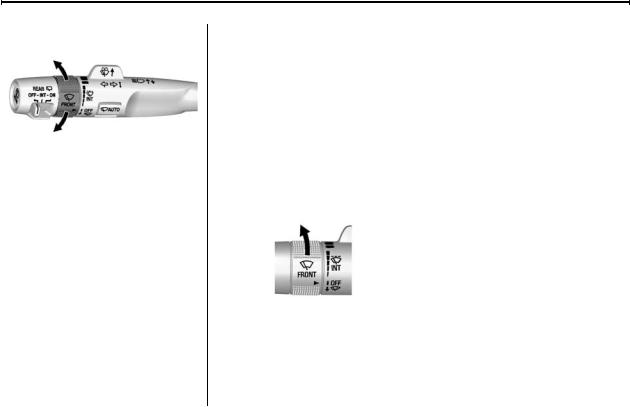
1-14 |
In Brief |
Windshield Wiper/Washer
The windshield wiper control is on the turn signal lever.
The windshield wipers are controlled by turning the band with z FRONT on it.
1 : Fast wipes. w: Slow wipes.
3INT: Turn the z FRONT band up for more frequent wipes or down for less frequent wipes.
OFF: Turns the windshield wipers off.
8 : For a single wipe, turn to 8, then release. For several wipes,
hold the band on 8 longer.
L m : Push the paddle at the top of the lever to spray washer fluid on the windshield.
Rainsense™
With Rainsense, a sensor near the top center of the windshield detects the amount of water on the windshield and controls the frequency of the windshield wiper.
3INT: Turn the z FRONT band on the wiper lever to adjust the sensitivity.
.Turn the band up for more sensitivity to moisture.
.Turn the band down for less sensitivity to moisture.
Move the band out of the 3INT position to deactivate Rainsense.
zAUTO: Press to turn Rainsense on or off. When turned
on and z FRONT is in one of the Rainsense wipe sensitivity positions, the wipers can be adjusted for more or less sensitivity to moisture. When turned off, the wipers operate as timed intermittent wipers and can be adjusted for more or less frequent wipes. A DIC message may be displayed when Rainsense is turned on or off.
See Windshield Wiper/Washer on page 5-3.
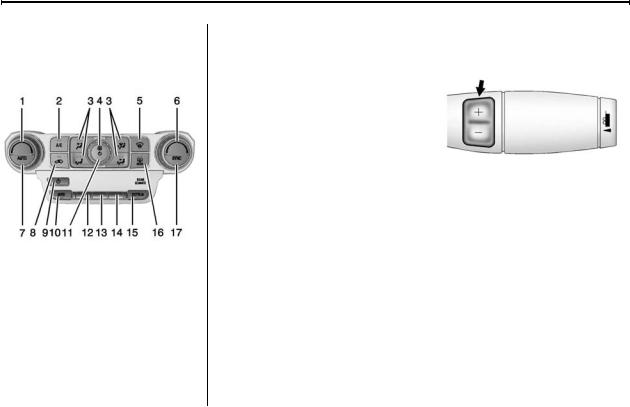
In Brief |
1-15 |
Climate Controls
This system controls the heating, cooling, and ventilation.
1.Driver Temperature Control
2.A/C (Air Conditioning)
3.Air Delivery Mode Controls
4.Fan Control
5.Defrost
6.Passenger Temperature Control
7.AUTO (Automatic Operation)
8.Air Recirculation
9.Rear Climate Control Power Button
10.Rear AUTO (Automatic Operation)
11.Front Climate Control Power Button
12.Rear Fan Control
13.Rear Air Delivery Mode Control
14.Rear Temperature Control
15.RCTRL (Rear Climate Control Lockout)
16.Rear Window Defogger
17.SYNC (Synchronized Temperature)
See Dual Automatic Climate Control System on page 8-1 and Rear Climate Control System on page 8-5
(if equipped).
Transmission
Range Selection Mode
The Range Selection Mode switch, if equipped, is on the shift lever.
1.To enable the Range Selection feature, move the shift lever to the M (Manual Mode) position. The current range will appear next to the M. This is the highest attainable range with all lower gears accessible. As an example, when 5 (Fifth) gear is selected, 1 (First) through
5 (Fifth) gears are available.
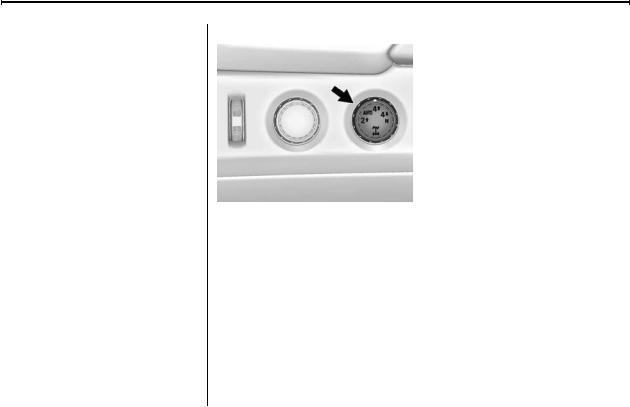
1-16 |
In Brief |
2.Tap the plus/minus buttons on the shift lever to select the desired range of gears for current driving conditions. See
Manual Mode on page 9-32.
While using Range Selection Mode, cruise control and the Tow/Haul Mode can be used.
Grade Braking is not available when Range Selection Mode is active. See Tow/Haul Mode on page 9-34.
Four-Wheel Drive
If the vehicle has four-wheel drive, you can send the engine's driving power to all four wheels for extra traction.
Automatic Transfer Case
Two Speed Automatic
Transfer Case
The transfer case knob is to the left of the steering wheel. Use this knob to shift into and out of the different four-wheel drive modes.
2 m : This setting is used for driving in most street and highway situations.
AUTO: This setting is ideal for use when road surface traction conditions are variable.
4 m : Use the Four-Wheel Drive High position when extra traction is needed, such as on snowy or icy roads or in most off-road situations.
4 n : Vehicles with a two speed automatic transfer case have a Four-Wheel Drive Low position. This setting sends maximum power to all
four wheels. You might choose 4 n if you are driving off-road in deep sand, mud, or snow, and while climbing or descending steep hills.
N (Neutral): Shift the transfer case to N (Neutral) only when towing the vehicle. See Recreational Vehicle Towing on page 10-77 or Towing the Vehicle on page 10-77.
See Four-Wheel Drive on page 9-35.

In Brief |
1-17 |
Vehicle Features
Infotainment System
See the infotainment manual for information on the radio, audio players, phone, navigation system, and voice or speech recognition. It also includes information on settings.
Steering Wheel Controls
The infotainment system can be operated by using the steering wheel controls. See "Steering Wheel Controls" in the infotainment manual.
Cruise Control
5 : Press to turn the system on or off. The indicator light is white when cruise control is on and turns off when cruise control is off.
SET −: Press briefly to set the speed and activate cruise control. If cruise control is already active, use to decrease vehicle speed.
+RES: If there is a set speed in memory, press to resume that speed or press and hold to accelerate. If cruise control is already active, use to increase vehicle speed.
* : Press to disengage cruise control without erasing the set speed from memory.
See Cruise Control on page 9-44 or Adaptive Cruise Control on
page 9-47 (If Equipped).
Driver Information
Center (DIC)
The DIC display is in the instrument cluster. It shows the status of many vehicle systems.
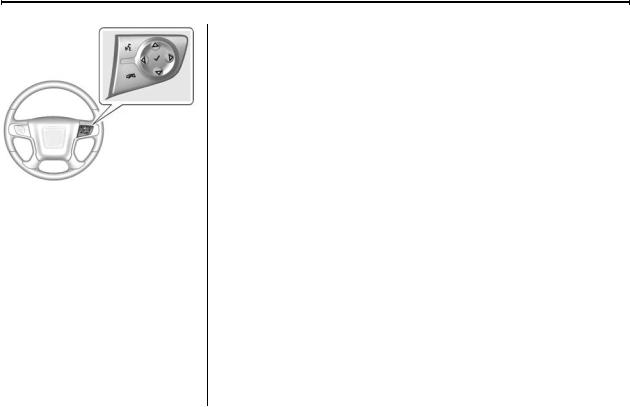
1-18 |
In Brief |
w or x : Press to move up or down in a list.
o or p : Press to move between the interactive display zones in the cluster.
V : Press to open a menu or select a menu item. Press and hold to reset values on certain screens.
See Driver Information Center (DIC) on page 5-30.
Forward Collision Alert
(FCA) System
If equipped, FCA may help avoid or reduce the harm caused by front-end crashes. FCA provides a
green indicator, V, when a vehicle is detected ahead. This indicator displays amber if you follow a vehicle much too closely. When approaching a vehicle ahead too quickly, FCA provides a flashing red alert on the windshield and rapidly beeps or pulses the driver seat.
See Forward Collision Alert (FCA) System on page 9-58.
Lane Departure
Warning (LDW)
If equipped, LDW may help avoid unintentional lane departures at speeds of 56 km/h (35 mph) or greater. LDW uses a camera sensor to detect the lane markings. The
LDW light, @, is green if a lane marking is detected. If the vehicle departs the lane, the light will
change to amber and flash. In addition, the driver seat will pulse or beeps will sound.
See Lane Departure Warning (LDW) on page 9-65.
Lane Change Alert (LCA)
If equipped, the LCA system is a lane-changing aid that assists drivers with avoiding lane change crashes that occur with vehicles in the side blind zone (or spot) areas or with vehicles rapidly approaching these areas from behind. The LCA warning display will light up in the corresponding outside side mirror and will flash if the turn signal is on. The Side Blind Zone Alert (SBZA) system is included as part of the LCA system.
See Side Blind Zone Alert (SBZA) on page 9-62 and Lane Change Alert (LCA) on page 9-62.

In Brief |
1-19 |
Rear Vision
Camera (RVC)
If equipped, RVC displays a view of the area behind the vehicle on the center stack display when the vehicle is shifted into R (Reverse) to aid with parking and low-speed backing maneuvers.
See Assistance Systems for Parking or Backing on page 9-55.
Rear Cross Traffic Alert
(RCTA) System
If equipped, the RCTA system uses a triangle with an arrow displayed on the RVC screen to warn of traffic behind your vehicle that may cross your vehicle's path while in
R (Reverse). In addition, beeps will sound, or the driver seat will pulse.
See Assistance Systems for Parking or Backing on page 9-55.
Parking Assist
If equipped, Rear Parking Assist (RPA) uses sensors on the rear bumper to assist with parking and avoiding objects while in
R (Reverse). It operates at speeds less than 8 km/h (5 mph). RPA may display a warning triangle on the Rear Vision Camera screen and a graphic on the instrument cluster to provide the object distance. In addition, multiple beeps or seat pulses may occur if very close to an object.
The vehicle may also have the Front Parking Assist system.
See Assistance Systems for Parking or Backing on page 9-55.
Active Emergency
Braking System
If the vehicle has Adaptive Cruise Control (ACC) it also has the Active Emergency Braking System, which includes Intelligent Brake
Assist (IBA) and the Automatic
Collision Preparation (ACP) System. These systems can provide a boost to braking or automatically brake the vehicle to help avoid or lessen the severity of crashes when driving in a forward gear.
See Active Emergency Braking System on page 9-60.
Power Outlets
Accessory power outlets can be used to plug in electrical equipment, such as a cell phone, MP3
player, etc.
The vehicle may have up to five accessory power outlets:
Vehicles with a Center Console
.One in front of the cupholders on the center console.
.One inside the center storage console.
.One on the rear of the center storage console.
.One in the third row seat on the driver side.
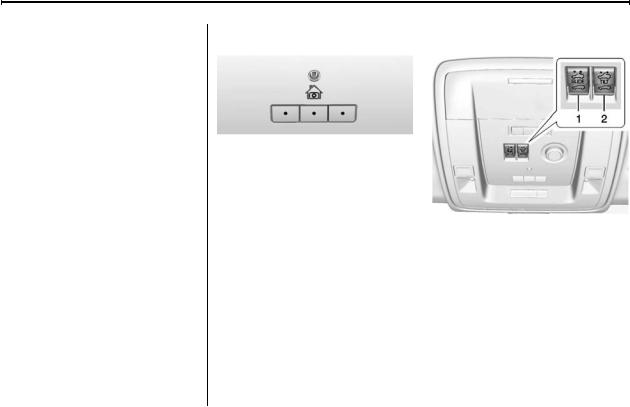
1-20 |
In Brief |
.One in the rear cargo area on the passenger side.
Vehicles with Bench Seats
.One on the center stack below the climate control system.
.One in the storage area on the bench seat.
.One on the rear of the center armrest storage.
.One in the third row seat area on the driver side.
.One in the rear cargo area on the passenger side.
Lift the cover to access and replace when not in use.
See Power Outlets on page 5-7.
Universal Remote System Sunroof
If equipped with the Universal Remote system, these buttons will be in the front overhead console.
This system provides a way to replace up to three remote control transmitters used to activate devices such as garage door openers, security systems, and home automation devices.
See Universal Remote System on page 5-58.
1.Open or Close
2.Vent
On vehicles with a sunroof, the sunroof only operates when the ignition is in ACC/ACCESSORY or ON/RUN, or when Retained Accessory Power (RAP) is active. See Retained Accessory Power (RAP) on page 9-25.
Vent: From the closed position, press the rear of switch (2) to vent the sunroof.

In Brief |
1-21 |
Open/Close: To open the sunroof, press and hold switch (1) until the sunroof reaches the desired position. Press and hold the front of switch (1) to close it.
Express-Open/Express-Close: To express-open the sunroof, fully press and release the rear of switch (1) until the sunroof reaches the desired position. To express-close the sunroof, fully press and release the front of switch (1). Press the switch again to stop it.
When the sunroof is opened, an air deflector will automatically raise. The air deflector will retract when the sunroof is closed.
The sunroof also has a sunshade which can be pulled forward to block sun rays. The sunshade must be opened and closed manually.
If an object is in the path of the sunroof while it is closing, the anti-pinch feature will detect the object and stop the sunroof.
See Sunroof on page 2-28.
Performance and
Maintenance
Traction Control/
Electronic Stability
Control
The vehicle has a traction control system that limits wheel spin and the StabiliTrak system that assists with directional control of the vehicle in difficult driving conditions. Both systems come on automatically when the vehicle is started and begins to move.
.To turn off traction control, press and release g on the instrument panel to the left of the steering wheel. The traction off light i displays in the instrument cluster. The appropriate DIC message displays. See Ride Control System Messages on page 5-44.

1-22 |
In Brief |
.To turn off both traction control and StabiliTrak, press and
hold g until i and g illuminate in the instrument cluster and the appropriate DIC message displays. See Ride Control System Messages on page 5-44.
.Press and release g again to turn on both systems.
.StabiliTrak will automatically turn on if the vehicle exceeds
56 km/h (35 mph). Traction control will remain off.
See Traction Control/Electronic Stability Control on page 9-41.
Tire Pressure Monitor
This vehicle may have a Tire Pressure Monitor System (TPMS).
The low tire pressure warning light alerts to a significant loss in pressure of one of the vehicle's tires. If the warning light comes on, stop as soon as possible and inflate the tires to the recommended pressure shown on the Tire and Loading Information label. See
Vehicle Load Limits on page 9-15. The warning light will remain on until the tire pressure is corrected.
The low tire pressure warning light may come on in cool weather when the vehicle is first started, and then turn off as the vehicle is driven. This may be an early indicator that the tire pressures are getting low and the tires need to be inflated to the proper pressure.
The TPMS does not replace normal monthly tire maintenance. Maintain the correct tire pressures.
See Tire Pressure Monitor System on page 10-50.
Engine Oil Life System
The engine oil life system calculates engine oil life based on vehicle use and displays a DIC message when it is necessary to change the engine oil and filter. The oil life system should be reset to 100% only following an oil change.
Resetting the Oil Life System
1.Display OIL LIFE REMAINING on the DIC. See Driver Information Center (DIC) on page 5-30.
2.Press and hold V for several seconds. The oil life will change to 100%.
The oil life system can also be reset as follows:
1.Turn the ignition to ON/RUN with the engine off.
2.Fully press the accelerator pedal slowly three times within
five seconds.

In Brief |
1-23 |
3.Display the OIL LIFE REMAINING on the DIC. If the display shows 100%, the system is reset.
See Engine Oil Life System on page 10-9.
Driving for Better Fuel Economy
Driving habits can affect fuel mileage. Here are some driving tips to get the best fuel economy possible.
.Avoid fast starts and accelerate smoothly.
.Brake gradually and avoid abrupt stops.
.Avoid idling the engine for long periods of time.
.When road and weather conditions are appropriate, use cruise control.
.Always follow posted speed limits or drive more slowly when conditions require.
.Keep vehicle tires properly inflated.
.Combine several trips into a single trip.
.Replace the vehicle's tires with the same TPC Spec number molded into the tire's sidewall near the size.
.Follow recommended scheduled maintenance.
Roadside Assistance
Program
U.S.: 1-888-881-3302
TTY Users (U.S. Only): 1-888-889-2438
Canada: 1-800-268-6800
New GMC owners are automatically enrolled in the Roadside Assistance Program.
See Roadside Assistance Program on page 13-5.
OnStar®
This vehicle may be equipped with a comprehensive, in-vehicle system that can connect to a live OnStar Advisor for Emergency, Security, Navigation, Connection, and Diagnostic Services. OnStar services may require a paid subscription. See OnStar Overview on page 14-1.
